Abstract
Appropriate driving technique, in compliance with eco-driving principles, remains an effective method to reduce fuel consumption. The selection of the correct gear is one of the pertinent factors when driving a car with a manual gearbox. In this study we have analyzed fuel overconsumption based on data recorded in real traffic conditions for vehicles driven by experienced drivers, using a black-box model. It was found that the total share of trip time with a lower than optimal gear selected amounted to from c.a. 3% for motorway driving up to 28% on rural roads. The mean fuel consumption reduction factor (following selection of the next gear up) amounted to from c.a. 2% up to 20%, depending on the selected gear and type of driving. Unfortunately, the potential for reduction of fuel consumption is not evenly distributed over the entire operating area of the engine. Thus, the cumulative reduction of fuel consumption, due to selection of the optimal gear, amounted to from c.a. 0.2% for motorway driving up to 3–6%, for urban and rural driving. It was shown that due to the selection of the appropriate gear, there still exists a real possibility of reduction of fuel consumption, even in the case of experienced drivers.
1. Introduction
The actual fuel consumption occurring during vehicle operation is a function of many factors having varying degrees of impact, such as engine design, vehicle age, driver behavior, road topography, fuel properties, resistive forces on the vehicle, ignition technology, cylinder head design, friction within the engine, ambient temperature and humidity, and many others []. These factors can be aggregated appropriately as factors related to vehicle characteristics and systems (vehicle mass, vehicle aerodynamics, tires, and auxiliary systems); to environmental and traffic conditions (meteorological and road conditions, level of service, traffic flow); and to the driver (driving behavior and user-related factors), respectively [,]. Analysis of the results of studies performed for light-duty vehicles regarding the effects of strategic, tactical, and operational driver decisions on fuel consumption are presented in a comprehensive study [], showing that the factors which are under the control of the driver can contribute to about 45% of the total reduction in on-road fuel consumption.
One of the possible actions to be taken by a driver in order to decrease fuel consumption is to apply eco-driving strategies. In a study on this subject [], potential fuel consumption savings were estimated by using the ratio between mean fuel consumption for aggressive driving behaviors and mean fuel consumption for non-aggressive behaviors. The aforementioned ratio permitted estimation of potential savings in fuel consumption per trip, allowing the conclusion to be drawn that a mean reduction in fuel consumption of 7.0% may be achieved. In another study [], the issue of estimation of the effects of changes in driving style on fuel consumption in the case of light-duty vehicles was raised. In the investigations, a representative set of population-wide driving cycles was implemented as a baseline for estimating fuel savings resulting from eco-driving. The authors estimated the average fuel savings per trip from eco-driving to be 6%, occurring alongside a 1.5% increase in trip duration.
In another study [], the effect of acceleration intensity on energy consumption and driving efficiency during road testing of a passenger vehicle was analyzed. It was shown that the intensity of acceleration, taking into account powertrain control variables, such as selection of the gear and the engine load has a significant impact on fuel consumption. The authors also assessed the relationship between the mean acceleration for the acceleration phase and unit energy consumption. Driving behavior is also important in the case of heavy-duty vehicles. The authors of a study on this subject [] investigated the known and potential further factors for reducing fuel consumption in heavy-duty vehicles. They found that modifying driving behavior has the potential to reduce fuel consumption, even for driving on narrow roads in mountainous areas. In another study [], the potential for fuel savings was estimated to be in the range from 5.2% to 9.0% on an annual basis (for driving in comparable settings), after inducing more efficient driving behavior for truck drivers.
According to various studies, changes in driving behavior following the preparation of drivers carried out within the framework of eco-driving training result in several percent reductions in fuel consumption. Effects of eco-driving initiatives aimed at urban bus drivers were investigated in []. In general, the results of the field trial showed that there was a statistically significant effect of the eco-driving initiative, with a 6.8% reduction in fuel consumption. However, several contextual factors were observed, limiting drivers’ ability to turn their eco-driving knowledge into practice. As concerns private drivers, a study performed in Australia proved the efficacy of eco-driving training []; the study found that driver education led to a statistically significant reduction in fuel consumption of 4.6%. In a study based on a driving simulator experiment [], the effectiveness of eco-driving training on promoting the concept of eco-driving, as well as inducing more fuel-efficient driving for both professional and non-professional drivers was examined. It was found that a training method in the form of guided practice driving was more effective for improving a drivers’ eco-driving level than knowledge-based information alone. A review of the observed efficiency of eco-driving training programs is presented in [].
Assessment of the possibility to reduce fuel consumption for hypothetical traffic scenarios and vehicle operating conditions requires tools in the form of reliable mathematical models estimating fuel consumption based on a set of selected input parameters. In a publication on the subject [], state-of-the-art fuel consumption models were summarized and classified in terms of their transparency into one of three types, namely: white-box, grey-box, and black-box models. White-box models are the most complicated, as they are based on the physical or chemical processes occurring within the engine. In contrast to white-box models, black-box models lack physics in their model structure. In black-box models, the complete vehicle (or its engine alone) is considered as the black-box, and input such parameters as engine speed, engine torque, engine output power, instantaneous speed and acceleration of the vehicle, average speed and acceleration, and operation model. Grey-box models are based on both insights into the system considered and experimental data. For each models type, the limitations and potential possibilities of fuel consumption modeling are discussed.
Driving control based on a fuel consumption model can be designed by using optimization algorithms. The issue of optimal driving profiles was discussed in many studies, e.g., in [,,,,,]. However, the driving profiles obtained as optimized solutions in terms of fuel consumption are not necessarily optimal when exhaust emissions are also taken into consideration []. In a study on this subject [], dynamic programming was employed for a diesel vehicle to find two different driving profiles, optimized for fuel consumption and NOx emission minimization, respectively. As was shown, the common approach of optimal driving for fuel economy is not non-optimal for NOx emission. The authors stated that considering emission criteria in algorithms for driver assistance is a key point to reduce vehicles’ environmental impact.
In the present study, the focus was on an assessment of the potential for real reductions in fuel consumption due to optimal gear selection in vehicles with a manual gearbox under conditions where the engine’s driveline torque took positive values. In the course of the tests, two cars (popular segment A family car models) were driven. The vehicles were driven within the framework of three types of motion: driving taking place on city roads, on rural roads, and motorways. The analyses were performed for the data collected as a result of simultaneously recorded vehicle dynamics and parameters of engine operation under real traffic conditions. Analysis of operational conditions of the vehicle can be performed using an approach based on the cumulative value of Vehicle Specific Power i.e., the power per mass unit required for a given combination of speed, acceleration, and road grade, e.g., as presented by [,]. However, due to the fact that the rotational speed of the engine constitutes an essential parameter of the analysis performed, in this study the following descriptive coordinates were used for the presentation of operational conditions of the vehicle: rotational speed of the engine—engine torque, as per [].
In order to perform a fuel-saving analysis, a black-box type model was used to estimate instantaneous fuel consumption, both for the recorded conditions and for the selected gear, as well as for simulated driving following a gearshift to the next highest gear. As a result of these analyses, distribution maps of the mean fuel consumption reduction factor were calculated for the case of optimal gear selection during driving in real traffic conditions on different road types—this approach is a novel idea. Moreover, from the practical point of view, the distribution maps of fuel consumption reduction factor and the frequency distribution maps for the engine operating points recorded during driving on different roads enables further combined analyses in terms of limitation of fuel consumption and emission of toxic exhaust gases compounds, which can be effectively mapped for various engine speed and torque coordinates [,]. Another novel and practical aspect of the research is to show the limitation of real fuel savings resulting from the selection of optimal gear according to types of vehicle propulsion (driving), propulsion modes, individual areas of engine operation, and engine performance.
2. Materials and Methods
2.1. Data Collection
In the course of the research presented, two family cars from segment A one tested, each having a 5-speed manual gearbox. The first car had a naturally-aspirated spark ignition engine (Vehicle 1), and the second car had a turbocharged diesel engine (Vehicle 2). The key parameters of these two vehicles are shown in Table 1.

Table 1.
Key parameters of the vehicles used for acquisition of the measured data.
The cars were driven by experienced drivers in real traffic conditions within the framework of three routes on roads in southern Poland, which were driven multiple times: (I) urban—comprising driving on streets in a medium-sized city, a loop of length 32 km, repeated 6 times; (II) rural—a loop length of 167 km, with portions of the road passing through foothill-type terrain, repeated 2 times; and (III) motorway, a loop of length 140 km, repeated 4 times. In Figure 1 the speed trace during one hour of driving is presented, as recorded for both vehicles on their respective routes.
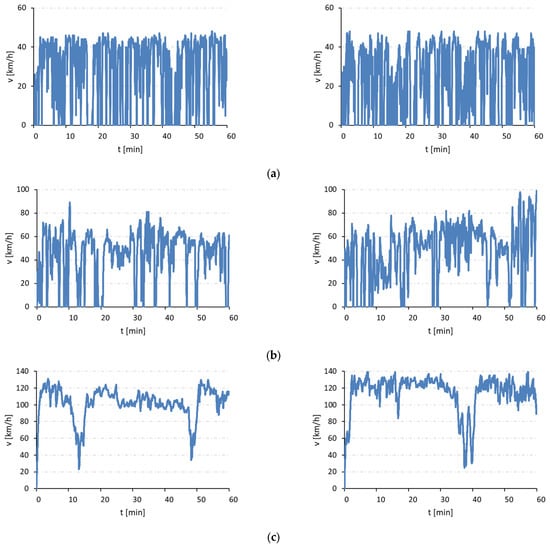
Figure 1.
Course of the speed for Vehicle 1 (on the right side), and Vehicle 2 (on the left side), recorded during one hour of driving on: (a) city streets, (b) rural roads, (c) motorways.
During the driving on defined routes, which were repeated multiple times, such motion parameters of the vehicles as: driving speed of the vehicle, the rotational speed of the engine, relative engine load, and selected gear were recorded. The recording was carried out by means of a computer connected directly to the test vehicle’s OBD system. Read-out of the motion parameters at a frequency of 1 Hz was performed using the ELM327 Interface (OBD → RS232 Interpreter), and the authors’ proprietary software developed at BOSMAL Automotive Research and Development Institute, allowing simultaneous archival of the data collected from the vehicles’ ECUs. On the basis of recorded data comprising engine speed and throttle position, instantaneous engine torque values were calculated. The measurement runs were performed over two days, amounting to 22 h per vehicle, which allowed data to be recorded over a total distance of 1086 km in the case of each vehicle.
2.2. Fuel Consumption Model
The issue of estimation of fuel consumption in given conditions of traffic requires the adoption of a model associating instantaneous fuel consumption of the vehicle with macroscopic propulsion parameters (i.e., vehicle motion parameters). In a study on that subject [], it was ascertained that black-box models are recommended in such applications, because the important influencing factors, including roadway-related, traffic-related, and driver-related factors are considered in models of that type. Moreover, black-box models are computationally faster than white-box and grey-box models.
In the present study, an approach based on the evaluation of instantaneous fuel consumption in relation to actual demand for tractive power was adopted. The fuel consumption rate in g s−1 is directly related to the power demand experienced by the engine, and thus []:
where is the power demand on the engine, k is the engine friction factor, n is engine speed, D is engine displacement, is a measure of indicated engine efficiency, w is the lower heating value of the fuel, and is the air/fuel equivalence ratio. This type of black-box model is capable of estimating the second-by-second fuel consumption of different vehicle/technology categories []. Furthermore, the results of our earlier work confirm that the model is capable of proper estimation of changes in the fuel flow rate occurring due to changes in driving dynamics [].
The engine power is calculated using the following approximation:
where is the traction power, is the engine power demand associated with the use of accessories, and is the combined efficiency of the transmission.
The tractive power was calculated on the base of known dynamic variables of the vehicle and important static variables such as mass, aerodynamic drag, rolling resistance, and road grade, using the formula:
where m is the total mass of the vehicle; v and a are instantaneous velocity and acceleration of the vehicle, respectively; are coefficients of reduced mass for the engine and the wheels, respectively; is the transmission ratio of the current gear, is the density of the ambient air, is the coefficient of aerodynamic drag, A is vehicle frontal area, g is the acceleration due to gravity, f is the rolling resistance coefficient and is road grade (angle).
The coefficients were calculated from the following formulas:
where IS, Iw are the sums of the inertia moments of the rotating masses related to the engine and the wheels respectively, is the final drive ratio and rt is the dynamic wheel radius. Values for constants used in the above formulas are listed in Table 2.

Table 2.
Values of constants used for calculation of fuel consumption.
The engine friction factor in formula (1) was calculated on the basis of engine bench tests performed for selected discrete rotational speed values. The results of these tests were generalized, by plotting approximating functions in the form of polynomials. The polynomial functions describing the variability of the engine friction factor of each engine, as used in the calculations, are illustrated in Figure 2.
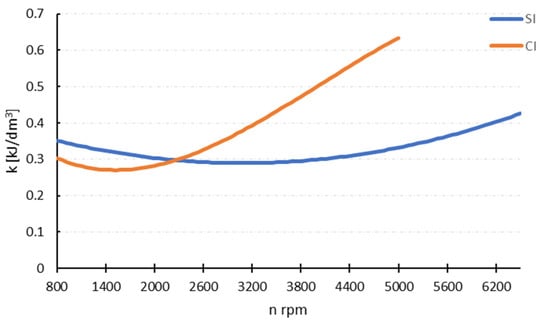
Figure 2.
The engine friction factor for Vehicle 1 (SI engine), and Vehicle 2 (CI engine).
The change of internal resistance of the engine occurring as a result of increasing rotational speed is greater in the case of Vehicle 2 (with a CI engine). In the case of this engine, the engine friction factor at maximum rotational speed is more than twice as large as the value at idling speed. In the case of Vehicle 1 (with an SI engine), the same change of the value of the engine friction factor amounts only to 25% of its value at idling speed. The considerable increase of the engine friction factor for Vehicle 2 (with a CI engine) for rotational speeds above 2300 rpm results from the increase of mechanical losses in the drive system of the high-pressure pump in the Common Rail system.
3. Results and Discussion
Due to repeated runs performed on the test vehicles on each of the routes, recorded data map real driving conditions of the vehicles in various situations on the road. Driving behavior in relation to dynamics can be characterized by means of many metrics, see e.g., []. Apart from the mean values of deceleration and acceleration, Relative Positive Acceleration (RPA) and Positive Kinetic Energy (PKE) are chosen as metrics in order to show differences in the dynamics recorded during driving on urban roads, rural roads, and motorways. The RPA and PKE are calculated as follows:
where is total trip distance, is the acceleration at time step i, is the speed at time step i, is the time increment, n is the total number of time steps.
Calculated values of the basic metrics, RPA, and PKE metrics for the data sets recorded during driving on different roads are presented in Table 3.

Table 3.
Characteristics of the data sets in terms of vehicle dynamics.
Analysis of the values of the metrics obtained confirms the existence of different traffic conditions recorded during driving on urban roads, rural roads, and motorways. Analyzing the values of the RPA and PKE metrics, it is easy to note that the highest driving dynamics—as could be expected—were recorded under urban driving conditions. Under motorway driving conditions, values of these parameters are nearly two times lower than for urban driving conditions. At the same time, it is worth emphasizing that as a result of the collection of data during many runs, in the case of both vehicles, values of the RPA and PKE are similar in the case of a given type of driving. Thus, RPA and PKE are the metrics that can be used to distinguish between different types of vehicle propulsion, i.e., different types of driving. In the case of Vehicle 2, which featured an engine of higher power output, 17% higher mean RPA values were recorded. The lowest difference was observed for urban driving; the highest was observed for motorway driving.
From this point of the paper onwards, data will be presented as a function of engine speed n and engine torque M. Engine operating points recorded in real traffic during driving on various road types are presented in Figure 3.
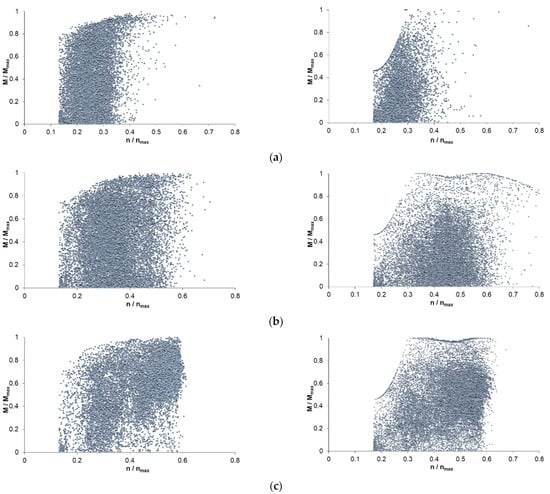
Figure 3.
Area of the engine operating points recorded in real traffic during driving on different roads for Vehicle 1 (on the right side) and Vehicle 2 (on the left side) (a) city roads, (b) rural roads, (c) motorways.
Analysis of the obtained distribution of recorded engine operating points enables identification of the most often used operating range of the rotational speed during a given type of driving. In the case of urban driving, only occasional occurrences of rotational speeds higher than 0.5 nmax were recorded. In the case of motorway driving, values of the recorded rotational speeds did not exceed a value of 0.65 nmax. The highest rotational speeds were recorded during rural driving; they occasionally exceeded a value of 0.7 nmax. Characteristics of the data set in terms of the rotational speed and engine torque, within the framework of the analyzed types of driving, are presented in Table 4.

Table 4.
Characteristics of the data sets in terms of recorded values of the engine speed and engine torque.
Analysis of the data presented in Table 4 leads to the conclusion that a wide range of rotational speeds was used in the case of Vehicle 1, while the engine operated in a lower load range in the case of Vehicle 2. Lower engine loads in the case of Vehicle 2 result from the correspondingly high torque of the engine and the higher flexibility of turbocharged engines. Simultaneously, in the case of both vehicles, the mean rotational speed for each type of motion is lower than 0.5 nmax. Frequency distribution maps of the engine operating points for these three types of motion, obtained based on the road testing performed, are presented in Figure 4.
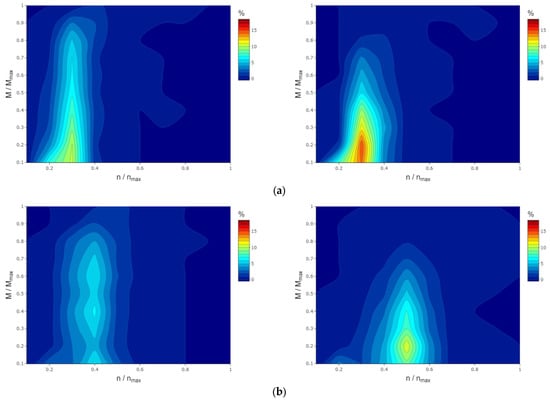
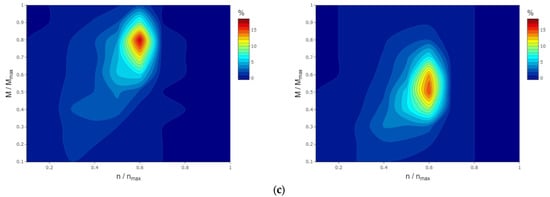
Figure 4.
Frequency distribution maps (i.e., timeshare, shown in percent) of the engine operating points recorded during driving on various roads for Vehicle 1 (on the right side) and Vehicle 2 (on the left side) (a) city roads, (b) rural roads, (c) motorways.
Actual fuel consumption at a given instantaneous point of the drive was calculated using model (1) for real engine power, evaluated based on the torque and rotational speed of the engine. At the same time, it was verified whether a gear shift from the current gear (i-th) to the next (higher) gear (j-th) would be possible due to the need to maintain adequate engine output power, i.e.,
with the simultaneously fulfilled limitation:
where is engine torque at engine speed .
Where these conditions would have been fulfilled, because of the change of inertial forces in the case of a gear shift to a higher gear, demand for traction power was calculated according to (3), while suitably corrected engine power was calculated according to (2). Next, again using model (1), fuel consumption was re-evaluated for the conditions with the higher gear selected. In the first step, for particular types of driving, the percentage timeshare of driving in a lower than optimal gear was evaluated. The results are summarized in Table 5.

Table 5.
Percentage share of trip time with lower than optimal gear selected.
The results obtained point to comparable total percentage timeshares for driving in a lower than optimal gear—in the cases of both test vehicles. In the cases of both Vehicle 1 and Vehicle 2, the total percentage share of driving time in a gear lower than optimal was lower for driving on motorways, and amounted to about 3%. In turn, the greatest share was noted for driving on rural roads, for which the total share amounted to about 28%. Under urban driving conditions, the total percentage timeshare of driving in a lower than optimal gear was slightly lower, yet it still exceeded a value of 20%. It is worth noting that in the case of both vehicles, regardless of the type of driving, in nearly 50% of the cases this corresponded to driving in 4th gear instead of 5th gear.
In the case of recorded real-world driving in a lower than optimal gear, the distribution of percentage share of the driving modes was also analyzed. The results are shown in Figure 5. All states in which acceleration of the vehicle motion was recorded were assigned “acceleration mode”. Respectively, states, where deceleration of the vehicle was recorded, and simultaneously demand traction power was higher than zero, were assigned “deceleration mode”. “Cruising mode” denotes a situation in which the velocity of the vehicle recorded at a given moment was unchanged compared with the previous moment. In general, from the data collected during driving of both vehicles, it can be seen that driving in a lower than optimal gear, in most cases, concerns the acceleration mode. For none of the analyzed types of driving did the share of the acceleration mode take values lower than 50%.

Figure 5.
Percentage share of drive modes for driving in a lower than optimal gear for Vehicle 1 (on the right side) and Vehicle 2 (on the left side) during driving on city roads, rural roads, and motorways.
Limitation of fuel consumption by the selection of the optimal gear during acceleration events of greater dynamics than occur for motorway driving is difficult, and may not be achievable by the average driver. However, for urban and rural driving conditions, there exists a portion of the deceleration and cruising modes for which reduction of fuel consumption by the selection of the optimal gear is, practically speaking, much more likely for trained drivers. For motorway driving conditions, due to the specifics of driving at high speeds, and the fact that the driver automatically selects the highest gear for the majority of such driving, such a method of reduction of fuel consumption in cruising mode will be of marginal importance.
To make a comparison of the potential for reduction of fuel consumption by a selection of optimal gear in real traffic conditions, for conditions of the driving in a lower than optimal gear, the average reduction factor of fuel consumption after selection of higher gear was determined. The results of the calculations are summarized in Table 6.

Table 6.
Average percentage fuel consumption reduction factor after selection of higher gear, calculated for motion conditions as recorded during the measurements.
Analysis of the data for Vehicle 1 generally points towards a lower mean fuel consumption reduction factor value for driving on urban and rural roads, compared to calculation results for Vehicle 2. For motorway driving, the mean values of the reduction factor are similar for both vehicles. From the data quoted above, it can be seen that the fuel consumption reduction effectiveness resulting from the selection of the proper gear will be significantly determined by individual driving behavior. Taking into consideration the share of time for driving in a lower than optimal gear (Table 5), elimination of driving in 3rd gear instead of 4th, and in 4th instead of 5th, have similar potential in terms of reduction of fuel consumption. Elimination of driving in 2nd gear instead of 3rd gear, while potentially the most promising in terms of the value of the mean percentage fuel consumption reduction factor is however of lower importance because the timeshare of such driving was relatively small in the driving conditions experienced by the test vehicles during on-road operation over the routes used in this study.
To assess the variability of the potential for reduction of fuel consumption over the entire area of engine operation, the distribution maps of average fuel consumption reduction factors were elaborated for the case of optimal gear selection during the drive on urban, rural, and motorways roads. The maps obtained in this manner are presented in Figure 6.
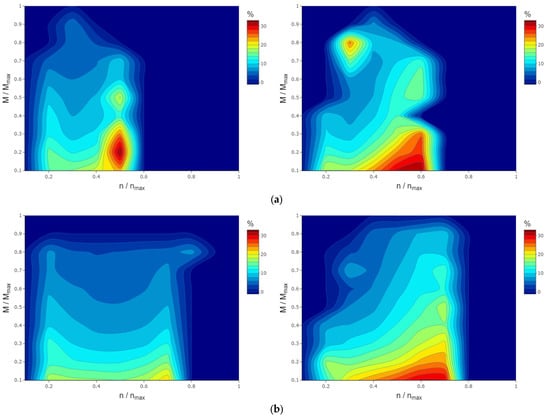
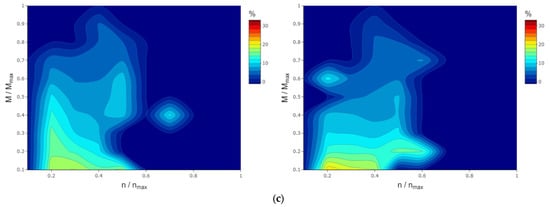
Figure 6.
Distribution maps of average percentage fuel consumption reduction factor for a case of optimal gear selection during driving on different roads for Vehicle 1 (on the right side) and Vehicle 2 (on the left side) (a) city roads, (b) rural roads, (c) motorways.
Comparison of the distribution maps of the average fuel consumption reduction factor with the frequency distribution maps indicates that the potential for the reduction of fuel consumption is not evenly distributed in the whole operational area of the engine. Potentially high values of the reduction factor within individual areas of engine operation are overlapping mainly with such areas of the engine operation where the frequency of the occurrence was low. This can be especially clearly seen for conditions of urban and motorway traffic, where the biggest potential reduction of fuel consumption covers selected areas of low engine load—up to 0.3 Mmax.
As a consequence of the non-overlapping of areas of frequent engine operation and potentially high values of the reduction factor, the cumulative reduction value of fuel consumption is limited. Despite the significant share of driving time in a non-optimal gear on each type of road, summary savings in fuel consumption in case of each type of motion will not exceed a few percent. For Vehicle 1, it was calculated that cumulative reduction of fuel consumption, due to selection of optimal gear, amounted to 3.3%, 3.6%, and 0.15% respectively for urban, rural, and motorway driving. In the case of the data recorded for Vehicle 2, the cumulative reduction of fuel consumption of 5.8%, 6.3%, and 0.2% respectively, for these kinds of motion was calculated.
4. Conclusions
In this study the authors analyzed the potential reduction in fuel consumption under real driving conditions, resulting from the selection of the optimal gear. The applied methodology required the collection of a large amount of data and simultaneous usage of models to estimate the fuel consumption in relation to the actual demand for tractive power. As a result of the analyses performed, it has been found that:
- Relative Positive Acceleration and Positive Kinetic Energy are the metrics that can be used to distinguish between different types of motion;
- The highest RPA values were obtained for the test vehicle with an engine of higher performance;
- Experienced drivers only occasionally used a higher rotational speed of the engine. In this study, the mean rotational speed for each of the driving conditions was lower than 0.5 nmax. Moreover, in urban driving, the 90th percentile value for rotational speed was less than 0.4 nmax. In the case of rural and motorway driving, the 90th percentile values of the recorded rotational speeds didn’t exceed 0.6 nmax;
- The total percentage share of trip time with a lower than optimal gear selected amounted to from c.a. 3% for driving on motorways up to 28% for driving on rural roads. Regardless of the type of driving, in nearly 50% of the cases of driving with a lower than optimal gear selected, this corresponded to driving in 4th gear instead of 5th gear;
- Most of the time, driving in a lower than optimal gear concerned the acceleration mode. Reduction of fuel consumption by the selection of optimal gear is more likely to be achieved in deceleration and cruising modes. These conditions were more frequently recorded for the condition of urban and rural motions than for driving on motorways;
- The mean normalized fuel consumption reduction factor after selection of a higher gear amounted to from c.a. 2% up to 20%, depending on the selected gear and the types of motion. Elimination of the driving in 3rd gear instead of 4th, and in 4th instead of the 5th, has similar potential terms of reduction of fuel consumption;
- The potential for reduction of fuel consumption is not evenly distributed over the whole operational area of the engine. Potentially high values of the reduction factor within individual areas of engine operation covers mainly selected areas of low engine load—up to 0.3 Mmax;
- Cumulative reduction of fuel consumption, due to selection of the optimal gear, amounted to from c.a. 0.2% (for motorway driving) up to 3–6% (for urban and rural driving). For comparable motion dynamics, a bigger reduction of the fuel consumption was calculated for a vehicle having a surplus of the engine torque.
In summary, it was shown that due to the selection of the appropriate gear, there still exists a real possibility of reduction of fuel consumption, even in the case of experienced drivers. The results show also the limitations of the real fuel-saving resulting from the selection of the optimal gear according to types of motion, motion modes, individual areas of engine operation, and engine performance.
Author Contributions
Conceptualization, K.B. and J.N.; Methodology, K.B. and J.N.; Software, T.P.; Validation, W.A., T.P., and K.B.; Formal Analysis, W.A. and T.K.; Investigation, W.A. and T.P.; Resources, W.A. and T.P.; Data Curation, W.A. and J.N.; Writing—Original Draft Preparation, K.B.; Writing—Review and Editing, J.N. and T.K. All authors have read and agreed to the published version of the manuscript.
Funding
This research received no external funding.
Conflicts of Interest
The authors declare no conflict of interest.
References
- Rakha, H.A.; Ahn, K.; Moran, K.; Saerens, B.; Van den Bulck, E. Virginia Tech Comprehensive Power-Based Fuel Consumption Model: Model development and testing. Transp. Res. Part D Transp. Environ. 2011, 16, 492–503. [Google Scholar] [CrossRef]
- Zhou, M.; Jin, H.; Wang, W. A review of vehicle fuel consumption models to evaluate eco-driving and eco-routing. Transp. Res. Part D Transp. Environ. 2016, 49, 203–218. [Google Scholar] [CrossRef]
- Fontaras, G.; Zacharof, N.-G.; Ciuffo, B. Fuel consumption and CO2 emissions from passenger cars in Europe—Laboratory versus real-world emissions. Prog. Energy Combust. Sci 2017, 60, 97–131. [Google Scholar] [CrossRef]
- Sivak, M.; Schoettle, B. Eco-driving: Strategic, tactical, and operational decisions of the driver that influence vehicle fuel economy. Transp. Policy 2012, 22, 96–99. [Google Scholar] [CrossRef]
- Faria, M.V.; Duarte, G.O.; Varella, R.A.; Farias, T.L.; Baptista, P.C. How do road grade, road type and driving aggressiveness impact vehicle fuel consumption? Assessing potential fuel savings in Lisbon, Portugal. Transp. Res. Part D Transp. Environ. 2019, 72, 148–161. [Google Scholar] [CrossRef]
- Miotti, M.; Needell, Z.A.; Ramakrishnan, S.; Heywood, J.; Trancik, J.E. Quantifying the impact of driving style changes on light-duty vehicle fuel consumption. Transp. Res. Part D Transp. Environ. 2021, 98, 102918. [Google Scholar] [CrossRef]
- Graba, M.; Mamala, J.; Bieniek, A.; Sroka, Z. Impact of the acceleration intensity of a passenger car in a road test on energy consumption. Energy 2021, 226, 120429. [Google Scholar] [CrossRef]
- Walnum, H.J.; Simonsen, M. Does driving behavior matter? An analysis of fuel consumption data from heavy-duty trucks. Transp. Res. Part D Transp. Environ. 2015, 36, 107–120. [Google Scholar] [CrossRef]
- Pinchasik, D.R.; Hovi, I.B.; Bø, E.; Mjøsund, C.S. Can active follow-ups and carrots make eco-driving stick? Findings from a controlled experiment among truck drivers in Norway. Energy Res. Soc. Sci 2021, 75, 102007. [Google Scholar] [CrossRef]
- Strömberg, H.K.; Karlsson, I.C.M. Comparative effects of eco-driving initiatives aimed at urban bus drivers—Results from a field trial. Transp. Res. Part D Transp. Environ. 2013, 22, 28–33. [Google Scholar] [CrossRef]
- Jeffreys, I.; Graves, G.; Roth, M. Evaluation of eco-driving training for vehicle fuel use and emission reduction: A case study in Australia. Transp. Res. Part D Transp. Environ. 2018, 60, 85–91. [Google Scholar] [CrossRef]
- Wu, Y.; Zhao, X.; Rong, J.; Zhang, Y. The effectiveness of eco-driving training for male professional and non-professional drivers. Transp. Res. Part D Transp. Environ. 2018, 59, 121–133. [Google Scholar] [CrossRef]
- Huang, Y.; Ng, E.C.Y.; Zhou, J.L.; Surawski, N.C.; Chan, E.F.C.; Hong, G. Eco-driving technology for sustainable road transport: A review. Renew. Sustain. Energy Rev. 2018, 93, 596–609. [Google Scholar] [CrossRef]
- Saboohi, Y.; Farzaneh, H. Model for developing an eco-driving strategy of a passenger vehicle based on the least fuel consumption. Appl. Energy 2009, 86, 1925–1932. [Google Scholar] [CrossRef]
- Mensing, F.; Bideaux, E.; Trigui, R.; Tattegrain, H. Trajectory optimization for eco-driving taking into account traffic constraints. Transp. Res. Part D Transp. Environ. 2013, 18, 55–61. [Google Scholar] [CrossRef]
- Saerens, B.; Van den Bulck, E. Calculation of the minimum-fuel driving control based on Pontryagin’s maximum principle. Transp. Res. Part D Transp. Environ. 2013, 24, 89–97. [Google Scholar] [CrossRef]
- Saerens, B.; Rakha, H.A.; Diehl, M.; Van den Bulck, E. A methodology for assessing eco-cruise control for passenger vehicles. Transp. Res. Part D Transp. Environ. 2013, 19, 20–27. [Google Scholar] [CrossRef]
- Dehkordi, S.G.; Larue, G.S.; Cholette, M.E.; Rakotonirainy, A.; Rakha, H.A. Ecological and safe driving: A model predictive control approach considering spatial and temporal constraints. Transp. Res. Part D Transp. Environ. 2019, 67, 208–222. [Google Scholar] [CrossRef]
- Li, J.; Liu, Y.; Zhang, Y.; Lei, Z.; Chen, Z.; Li, G. Data-driven based eco-driving control for plug-in hybrid electric vehicles. J. Power Sources 2021, 498, 229916. [Google Scholar] [CrossRef]
- Gao, J.; Chen, H.; Li, Y.; Chen, J.; Zhang, Y.; Dave, K.; Huang, Y. Fuel consumption and exhaust emissions of diesel vehicles in worldwide harmonized light vehicles test cycles and their sensitivities to eco-driving factors. Energy Convers. Manag. 2019, 196, 605–613. [Google Scholar] [CrossRef]
- Fernández-Yáñez, P.; Soriano, J.A.; Mata, C.; Armas, O.; Pla, B.; Bermúdez, V. Simulation of Optimal Driving for Minimization of Fuel Consumption or NOx Emissions in a Diesel Vehicle. Energies 2021, 14, 5513. [Google Scholar] [CrossRef]
- Sentoff, K.M.; Aultman-Hall, L.; Holmén, B.A. Implications of driving style and road grade for accurate vehicle activity data and emissions estimates. Transp. Res. Part D Transp. Environ. 2015, 35, 175–188. [Google Scholar] [CrossRef]
- Duarte, G.O.; Gonçalves, G.A.; Farias, T.L. Analysis of fuel consumption and pollutant emissions of regulated and alternative driving cycles based on real-world measurements. Transp. Res. Part D Transp. Environ. 2016, 44, 43–54. [Google Scholar] [CrossRef]
- Gallus, J.; Kirchner, U.; Vogt, R.; Benter, T. Impact of driving style and road grade on gaseous exhaust emissions of passenger vehicles measured by a Portable Emission Measurement System (PEMS). Transp. Res. Part D Transp. Environ. 2017, 52, 215–226. [Google Scholar] [CrossRef]
- Sobieszczański, M.; Brzozowski, K.; Nowakowski, J.; Tekielak, K. The impact of SI engine controlling parameters on the content of toxic components and smokiness of exhaust gases. Eksploat. Niezawodn. 2008, 3, 53–61. [Google Scholar]
- Brzozowski, K.; Nowakowski, J. Toxicity of exhaust gases of compression ignition engine under conditions of variable load for different values of engine control parameters. Eksploat. Niezawodn. 2011, 4, 56–62. [Google Scholar]
- Barth, M.; Boriboonsomsin, K. Energy and emissions impacts of a freeway-based dynamic eco-driving system. Transp. Res. Part D Transp. Environ. 2009, 14, 400–410. [Google Scholar] [CrossRef]
- Adamski, W.; Brzozowski, K. Wyznaczanie zużycia paliwa i emisji dwutlenku węgla dla pojazdu z silnikiem ZI. Arch. Mot. 2009, 1, 67–83. [Google Scholar]
- Ericsson, E. Independent driving pattern factors and their influence on fuel-use and exhaust emission factors. Transp. Res. Part D Transp. Environ. 2001, 6, 325–345. [Google Scholar] [CrossRef]
Publisher’s Note: MDPI stays neutral with regard to jurisdictional claims in published maps and institutional affiliations. |
© 2021 by the authors. Licensee MDPI, Basel, Switzerland. This article is an open access article distributed under the terms and conditions of the Creative Commons Attribution (CC BY) license (https://creativecommons.org/licenses/by/4.0/).